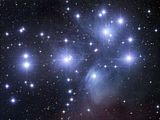Also on Tuesday evening, a 12% crescent Moon moves into conjunction with the Pleiades. "Into conjunction" is astronomy jargon for "side-by-side." The Moon will be so close to the Pleiades that, to the naked eye, they seem to touch, but that is impossible because the Pleiades are 400 light years away.
Also known as the Seven Sisters, the Pleiades are a cluster of young stars. The brightest seven of these blue-white beauties form a little dipper shape about as wide as the Moon. In spite of their great distance, the Pleiades are faintly visible to the naked eye even from urban areas.
On April 8th, the Moon will lead you directly to the Pleiades. Binoculars are recommended: scan around the Moon and you will find not just seven but dozens of sparkling stars, some of them winking in and out behind the mountainous lunar limb. The Moon itself may take your breath away as you sweep your optics across the cratered Earthlit landscape.
The best time to look is shortly after sundown, facing west. The crescent Moon, Earthshine, ISS, and a star cluster in the same field of view--it doesn't get much better than that.

A deep-sky exposure of the Pleiades star cluster by amateur astronomer Robert Gendler: Perhaps the most famous star cluster in the sky, the Pleiades can be seen without binoculars from even the depths of a light-polluted city. Also known as the Seven Sisters and M45, the Pleiades is one of the brightest and closest open clusters. The Pleiades contains over 3000 stars, is about 400 light years away, and only 13 light years across. Quite evident in the above photograph are the blue reflection nebulae that surround the brighter cluster stars. Low mass, faint, brown dwarfs have also been found in the Pleiades.
No comments:
Post a Comment